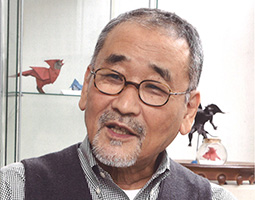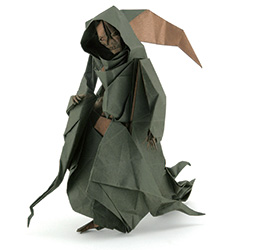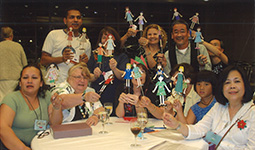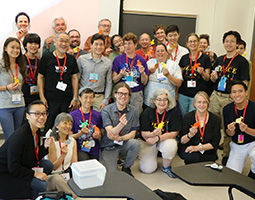INDEX
- English
- 日本語

Yamaguchi Makoto’s work Renjishi - English
- 日本語

Yamaguchi Makoto’s work Hina Dolls, based on traditional Japanese ornamental dolls

Yamaguchi Makoto 
Christmas Tree, one of Yamaguchi Makoto’s best-known works 
Miyamoto Chuya’s work Grim Reaper 
OrigamiUSA convention participants with dolls designed by Yamaguchi Makoto (back row, far right) 
Attendees of a seminar by Yamaguchi Makoto at the OrigamiUSA convention in New York. Yamaguchi is in the center row, third from the left
December 2021
The World of Origami

Folding paper to create a variety of shapes, or origami, is one Japanese cultural tradition. We spoke with Yamaguchi Makoto, an origami artist, Board of Directors President for the Japan Origami Academic Society, and representative of Origami House, a Tokyo gallery that specializes in origami, about the history and characteristics of Japanese origami.

Please tell us about the origins of Japanese origami.
In fact, it is not clear precisely when origami began in Japan. But when the samurai ruled during the Muromachi period (from the 1430s until the second half of the 16th century), origata, a method of folding paper to wrap gifts and letters, had developed as a form of etiquette for the samurai and that tradition was passed down through the Edo period (1603–late 1860s). This origata is considered one of the origins of modern Japanese origami.
By the Edo period, paper mass production began and origami spread to the general public as a form of entertainment. We see modern Japan’s most common paper creation, orizuru (paper crane), appearing in books introducing ukiyo-e prints and kimono fabric patterns from the early eighteenth century. Hiden Senbazuru Orikata (“Secret to Folding One-thousand Cranes”) was published in 1797 and it is believed to be the world’s oldest book on recreational origami. This book introduces renzuru folding methods, using which many interlocked cranes can be folded from a single sheet of paper.

There was also paper folding in Europe, though its origins are unclear. One traditional paper-folding technique is Spain’s pajarita (meaning “small bird” in Spanish). As the name suggests, a popular pajarita creation imitates a small bird and most Spanish people know it, just as people in Japan know the orizuru paper crane.
Friedrich Fröbel (1782–1852), the German educator renowned for creating the world’s first kindergarten, incorporated traditional European paper folding into his early childhood learning curriculum. Paper folding for such educational purposes was brought to Japan during the Meiji period (1868–1912) when Japan created an education system modeled on Western systems. So, in Japan, traditional European and Japanese origami was taught in kindergartens and elementary schools, and eventually became extremely popular at home.
When did Japanese origami find its way overseas?
It was after World War II that Japanese origami gained recognition as a form of art and spread around the world. That was largely the result of work by the origami artist Yoshizawa Akira (1911–2005). One after another, Yoshizawa created highly artistic origami that were full of life in the shapes of animals and other things. He held exhibitions and seminars in various countries and worked relentlessly to popularize origami around the world. That’s why he is highly respected among origami artists both in Japan and abroad even today. It was the American origami artist Lillian Oppenheimer (1898–1992), someone who kept in touch with origami artists around the world including Yoshizawa, who suggested using the Japanese word “origami” to describe paper folding during her efforts to popularize origami in the United States. We could say that it was thanks to her that the term origami came to be used all around the world.

I began my career as an origami artist in the late 1970s, when origami was not a common hobby in other countries. Recently, however, origami associations have been set up in different countries and origami festivals are held, so most people overseas have learned about origami. Before the spread of coronavirus, I traveled abroad almost every year for lectures and conventions on origami. At one time, when I told airport immigration officers that I was traveling to teach origami, they would often ask me what origami was. But recently that rarely ever happens.
In addition to your career as an origami artist, you have written approximately 150 books on origami. What particular kind of origami do you try and make?
I like making simple and cute pieces that anyone can make. Some of them are unique creations where you cut part of the paper, but I mostly use one sheet of square paper with no cuts. Sometimes I’ll make single works from multiple pieces of paper so that they are easy to fold and have beautiful designs. For example, I made origami in the motif of Renjishi (Two Lions), a famous play in the Japanese traditional art of kabuki by request from an origami paper manufacturer. To make Renjishi, I used one sheet for the top half of the body and one sheet for the bottom, then joined them together to make one kabuki actor. Also, the Christmas tree I made right at the start of my origami career uses one sheet of paper for the trunk and 5 or 6 papers of different sizes for the leaves.
I’m so fortunate that many people in Japan and abroad make these works, so they are my best-known works. I would like to create works that many people will love and pass down over the years.
What are the current trends in the origami world?
Origami is not unique to Japan, but I think it was Japan that developed the culture and techniques of origami. However, the number of origami enthusiasts around the world has grown as the Internet spreads information on origami beyond national boundaries, and I think it’s fair to say that the origami world is becoming more and more international. Within that trend, we’re seeing extremely talented young origami artists appear both in Japan and abroad.
Particularly in recent years, a style of extremely complex origami called “super complex” origami has become popular. Kamiya Satoshi, for example, has created numerous super complex pieces like Ryu-zin 3.5 and he has a kind of “star” status among fans of super complex origami. Also, Miyamoto Chuya’s piece Grim Reaper requires around 460 folds to complete and could probably be called one of the pieces of art made from a single piece of square paper with the largest number of folds in the world.

What about origami appeals to you?
The American origami artist Michael Shall (1949–1995) said, “Origami is for anyone, anywhere, any time.” Those words perfectly convey the appeal of origami in that all you need to enjoy origami is a single sheet of paper.
Origami also lets people connect with one another. For example, even if you can’t speak someone’s language, if you make a piece of origami and give it to them, anyone will be delighted. To me, I get the most joy from being able to connect with others in this way through origami. These days, you can learn origami easily through the Internet. If you learn a favorite origami folding technique, that will be very useful for making connections with every kind of person.



